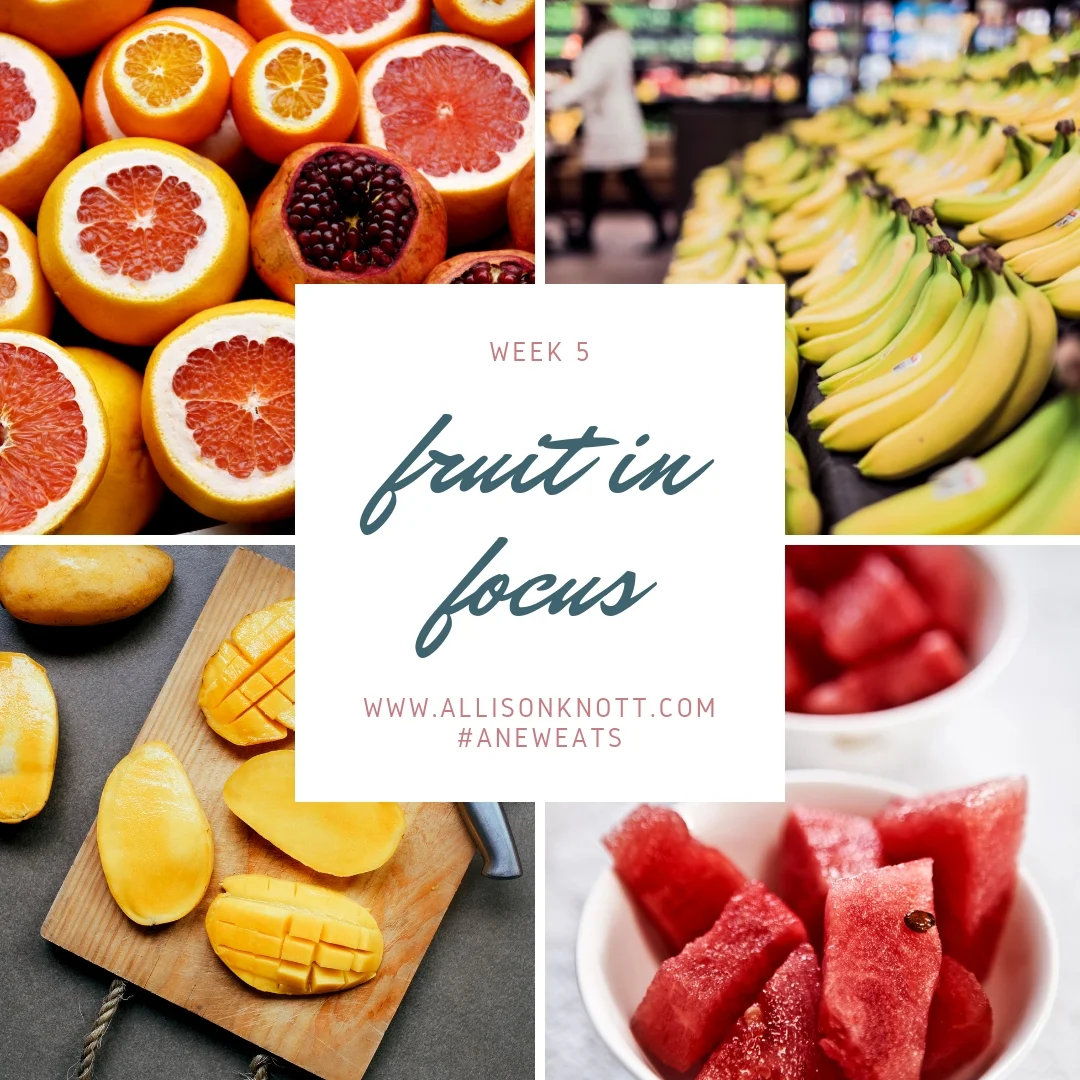15 Weeks of More
Enjoy More
Week 5: Fruit in Focus
October is proving to be an eventful month so far. I was fortunate to attend and speak at a wellness conference over the weekend. It was a busy two day filled sessions on a variety of wellness topics from creating a brand to mediation to nutrition. Many of the attendees to my Nutrition 101 session had questions about added sugar and carbohydrates which aligns perfectly with this week's theme. We will explore this topic here and throughout the week. If you have questions or want to share your experience with 15 Weeks of More so far, please email me! I would love to hear from you.
-----------
Week 5: Fruit in Focus
Eating fruit shouldn't be complicated, but unfortunately there continues to be confusion about this important food group. First, let's start with how many servings of fruit are recommended per day. For the average person consuming around 2000 calories per day, the recommendation is to eat 2 cup equivalents daily. If you remember from Week 4, similar to how not every vegetable preparation equals a cup serving, the same goes for fruit since we can consume fruit in a variety of ways. Dried fruit, whole, fresh fruit, canned, unsweetened fruit, and 100% fruit juice all count in the fruit serving. The most important thing to remember with fruit is that it shouldn't contain added sugar. For most fruits, one cup of whole fruit or 100% fruit juice counts as a cup serving while 1/2 cup of dried fruit counts as a cup serving. You can read more about the serving amounts by fruit type here.
--------
Your goal this week is to eat a minimum of two servings of fruit every day.
--------
This goal isn't out of reach for the majority of people. An apple or banana in the morning plus a dried fruit mixed into a trail mix as a snack would help you reach your goal. Don't over complicate something that should be easy and delicious! Many fruits are in season this type of year including apples, pears, and citrus. Look for sales on seasonal fruits the next time you're in your local grocery store. If you decide to venture out and try a fruit you've never had or if you are feeling creative with your fruit additions, share with #aneweats on Instagram or to the ANEWtrition facebook page. You can also send your photos to me and I'll share through my channels as well.
What is fructose?
Fructose is a type of sugar found in fruit. More specifically, fructose is a monosaccharide meaning it is not bonded to another sugar. When fructose bonds with glucose it forms table sugar or sucrose. Most of fruit's bad reputation comes from misunderstandings about fructose. Fructose that has been removed from fruit or concentrated to form a syrup is digested and absorbed more rapidly. This response can be negative for health and is the primary reason why added sugar is something to be limited in the diet. However, fructose found in the context of the whole fruit is different because it is a part of a larger package. This package contains fiber, water, phytonutrients, antioxidants, vitamins, and minerals. The fiber takes longer to digest which results in a slower rise in blood sugar. Consider apples or oranges, when eaten as a whole fruit, the combination of sugar with fiber slows the digestion and absorption. Apple juice or orange juice have fiber removed which will lead to those natural sugars being absorbed more quickly and in a greater volume leading to excess sugar intake versus eating a piece of whole fruit.
Juicing vs. Smoothies
There’s no shortage of marketing touting the benefits of juicing as an aid for weight loss, immune support, or detoxing. Simultaneously, smoothies are emphasized as necessary for health. This is the type of messaging that can lead to serious confusion. Smoothies are made by blending whole fruits and vegetables into a liquid, drinkable form. Their components often include produce along with a source of protein (milk, non-dairy milk, tofu, etc.) and/or fat (nuts, seeds, nut butters, etc.). Juice is made by squeezing the fruit or vegetable to form a juice leaving behind the peel or fibrous components and typically do not contain protein or fat. This often means that fresh squeezed juice has a greater number of fruits or vegetables by volume than smoothies, but with an increased likelihood of resulting in a rapid blood sugar rise. Foods with higher fiber content will not result in as rapid of a blood sugar rise. I recommend juice as something that is consumed rarely with a preference to whole fruit. Keep in mind that any juice or smoothie should be 100% fruit and free from added sugars.
I will be on social this week sharing all things fruit and I'm looking forward to connecting with you! Don't forget to share your tips and ideas with #aneweats.
You can see more on Instagram @allisonknottrd or on Facebook on the ANEWtrition page.
New here? Check out the introduction to 15 Weeks of More, Week 1, Week 2, Week 3, and Week 4.
See you on social!
Allison
